You are using an out of date browser. It may not display this or other websites correctly.
You should upgrade or use an alternative browser.
You should upgrade or use an alternative browser.
Best combo?
- Thread starter cab9379
- Start date
This kind of a loaded question..But to me I like the way that maples, cocobolo and bocote hit the best..
This kind of a loaded question..But to me I like the way that maples, cocobolo and bocote hit the best..
i second bocote and maple but id also like to add ebony.:grin-square:
What is the best wood to use for the best hit on a cue I've heard Pau Ferro, and Gongalo Alves, but I want to know from people that makes cues everyday. I don't care about looks I just want to know what wood makes the cue hit the best. Thank You.
You heard wrong. More precisely, you didn't get the full story.
First, there is no such thing as The Best Hit, "good hit" is such a subjective
quality, that varies widely, some might even say wildly, from player to player,
that it comes down to individual prefrence.
Though it is certainly true that a good hitting cue can be built using
either of those woods, the same level can be obtained from Ebony,
any of the Rosewoods, Bubinga, Purpleheart and many more, even as
Joe said - common as apple pie Sugar Maple.
If you do a search on AZ and Usenet, you will find enough chatter
to keep Evelyn Wood reading full time for a week.
There is much more to building a good hitting cue than just the wood
in the butt.
Dale
Last edited:
pdcue,You heard wrong. More precisely, you didn't get the full story.
First, there is no such thing as The Best Hit, "good hit" is such a subjective
quality, that varies widely, some might even say wildly, from player to player,
that it comes down to individual prefrence.
Though it is certainly true that a good hitting cue can be built using
either of those woods, the same level can be obtained from Ebony,
any of the Rosewoods, Bubinga, Purpleheart and many more, even as
Joe said - common as apple pie Sugar Maple.
If you do a search on AZ and Usenet, you will find enough chatter
to keep Evelyn Wood reading full time for a week.
There is much more to building a good hitting cue than just the wood
in the butt.
Dale
I'll agree the hit is a personal thing but want to expand on this question.
Lets say I like ebony. Is there a preferred wood to combine with it? Or maple and what wood? ....
I like a lot of feed back. So what woods when combined resonate well? Or if I want a ringing bell do I need to stay with one piece, no ring work, no inlay, no points?
Last edited:
Brazilian rosewood forearm, old growth maple handle and shaft ought to do it.:grin:
I like Joey's choice a lot.
As a matter of fact, I just mailed such a cue to Israel today.
Brazilian Rose forearm & butt-sleeve, Old Growth BEM handle.
2 shafts, one mine, the other a 314-2. All with my sig. ring-work at all locations. This cue hits sweet.
The old-version Aegis ferrule on the KJ shaft will certainly talk to you.
Your grip-hand says 'thank you'.
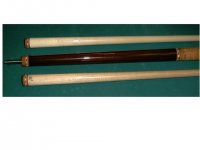
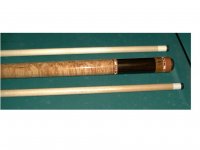
Good points being made in this thread, but it's not just the wood or just the build quality. It's both. The build will compliment the wood and the wood will compliment the build. If you don't have both, you don't have all that cue should be.
Many woods will give you good feedback, not the least of which is Maple.
I'm discovering that the Rosewoods speak the 'language' very well.
Don't expect them to hold their peace because they won't.
It all depends on what you want in a cue.
As a matter of fact, I just mailed such a cue to Israel today.
Brazilian Rose forearm & butt-sleeve, Old Growth BEM handle.
2 shafts, one mine, the other a 314-2. All with my sig. ring-work at all locations. This cue hits sweet.
The old-version Aegis ferrule on the KJ shaft will certainly talk to you.
Your grip-hand says 'thank you'.


Good points being made in this thread, but it's not just the wood or just the build quality. It's both. The build will compliment the wood and the wood will compliment the build. If you don't have both, you don't have all that cue should be.
Many woods will give you good feedback, not the least of which is Maple.
I'm discovering that the Rosewoods speak the 'language' very well.
Don't expect them to hold their peace because they won't.
It all depends on what you want in a cue.
Last edited:
What is the best wood to use for the best hit on a cue I've heard Pau Ferro, and Gongalo Alves, but I want to know from people that makes cues everyday. I don't care about looks I just want to know what wood makes the cue hit the best. Thank You.
Thats like asking whats the best truck to use to pull a camper.
OK well I guess I don't know how to put this, but I thought there was just one wood that most people prefer over the other because of the hit that this kind of wood produces.
Perhaps you might explain why you think this.
I'm still sayin' lots of different people prefer various woods and/or
combinations of woods.
However, though there may be one wood that is more popular than any
other, and how would one ever determine which one, ther is no
universally accepted single wood. At lleast, not that I am aware of, nor
anyone I know.
Dale
If I had endless supply of those woods ( exclusively ) , I'd just make them until I quit. There'd be PLAYERS who'd want them forever .I like Joey's choice a lot.
As a matter of fact, I just mailed such a cue to Israel today.
Brazilian Rose forearm & butt-sleeve, Old Growth BEM handle.
2 shafts, one mine, the other a 314-2. All with my sig. ring-work at all locations. This cue hits sweet.
The old-version Aegis ferrule on the KJ shaft will certainly talk to you.
Your grip-hand says 'thank you'.
Good points being made in this thread, but it's not just the wood or just the build quality. It's both. The build will compliment the wood and the wood will compliment the build. If you don't have both, you don't have all that cue should be.
Many woods will give you good feedback, not the least of which is Maple.
I'm discovering that the Rosewoods speak the 'language' very well.
Don't expect them to hold their peace because they won't.
It all depends on what you want in a cue.
Good Thread...i hope many cuemaker participate in this thread...and can give us a newbie more knowledge about the good wood for making a good pool cue.
Right now, there is cory barnhart brazilian rosewood plain jane wrapless on the way to me...any idea??? if brazilian rosewood will make a good hit.
The handle, i believe is rosewood too.
sorry, if my english is awfull. i hope someone know what i mean....
Best
Dedy (indonesia):smile:
Right now, there is cory barnhart brazilian rosewood plain jane wrapless on the way to me...any idea??? if brazilian rosewood will make a good hit.
The handle, i believe is rosewood too.
sorry, if my english is awfull. i hope someone know what i mean....
Best
Dedy (indonesia):smile:
I can only speak for what I like. My best advise it to try as many diffrent cues as you can and use your current cue for comparison.
i think maple is the most common wood in the forearm of a cue due to cost and to the fact that most maple hits great there has been a few makers over time that have only made their fronts out of maple for this purpose and to keep the hit of their cues as consistant as possible. considering that alot of people core their cues with maple, or use maple handle, and shaft wood is predominatly maple id have to say its the best for "a good hit" which is of course subjective. but the percentages are in its favor.
ill post pics of a 6 point with venneer curly maple cue im working on in a couple weeks everything is curly maple the handle forearm buttsleeve points with nice ringwork and 3 veeners.
ill post pics of a 6 point with venneer curly maple cue im working on in a couple weeks everything is curly maple the handle forearm buttsleeve points with nice ringwork and 3 veeners.
50% of your forearm wood is birdseye MAPLE, curly MAPLE, or straight grain MAPLE and there is a reason for that. It plays great and looks good.Not to say others don't but MAPLE by far is the most popular. But I play with bocote because I like the feel of it.
Historically (and I'm a traditional guy) the forearm of a 2-piece cue is maple. Straight grain air-dried maple. Later (and sometimes mixed in the older cues) the maple chosen would have a bit of flame to it, and/or bird's eye figure either by design, or by chance.
Points are traditionally one of the rosewoods, ebony or purple heart. Generally a hard, stiff, stable wood was used for the points/handle/butt (because the old cues were full spliced and needed to stay reasonably straight, and also to add some weight). Other woods were also used, sometimes on purpose, other times because something got mixed in with the wood used by the big manufacturers of the day (mainly Brunswick) or the supply of whatever they were using dried up and they had to try something else.
Once the full splice became obsolete, in about the mid-70's (George Balabushka and others were cutting full splice blanks just above the wrap area to add rings etc. so why make a long full-size full splice blank if you don't have to?) the flood gates were open for all sorts of woods, with a big driver being you no longer needed a 25+ inch long stick staying perfectly straight and being perfectly spliced into a forearm to make a cue. Four small 'scraps' of wood could be used to make v-groove points and maybe used in the butt sleeve as well if you wanted to. Handles were traditionally 'less fancy' straight grain maple at this point because they were under the wrap anyway.
What does all this mean? To you I have no idea. If you are asking what was traditional and why, this may help. If you want to know what is most popular these days, you may have to do a poll of all the cue makers here and find out.
PS this is in no way all inclusive of the woods traditionally used in cues- the forearm being straight maple (pretty much always) is a by-product of full splice one-piece cues: the forearm as we know it now in a 2-piece cue was also the shaft in those one-piece cues and that had to stay straight. Fancy figured woods tend to have more internal stress in them than straight grain woods of the same species, and from a manufacturing point of view (Leo Fender did this as well by the way- lots of highly figured necks went into the dumpster!) the 'fancy' figured wood was often tossed as less desirable back then due to its sometimes unpredictable nature no matter how careful you were with it...
Points are traditionally one of the rosewoods, ebony or purple heart. Generally a hard, stiff, stable wood was used for the points/handle/butt (because the old cues were full spliced and needed to stay reasonably straight, and also to add some weight). Other woods were also used, sometimes on purpose, other times because something got mixed in with the wood used by the big manufacturers of the day (mainly Brunswick) or the supply of whatever they were using dried up and they had to try something else.
Once the full splice became obsolete, in about the mid-70's (George Balabushka and others were cutting full splice blanks just above the wrap area to add rings etc. so why make a long full-size full splice blank if you don't have to?) the flood gates were open for all sorts of woods, with a big driver being you no longer needed a 25+ inch long stick staying perfectly straight and being perfectly spliced into a forearm to make a cue. Four small 'scraps' of wood could be used to make v-groove points and maybe used in the butt sleeve as well if you wanted to. Handles were traditionally 'less fancy' straight grain maple at this point because they were under the wrap anyway.
What does all this mean? To you I have no idea. If you are asking what was traditional and why, this may help. If you want to know what is most popular these days, you may have to do a poll of all the cue makers here and find out.
PS this is in no way all inclusive of the woods traditionally used in cues- the forearm being straight maple (pretty much always) is a by-product of full splice one-piece cues: the forearm as we know it now in a 2-piece cue was also the shaft in those one-piece cues and that had to stay straight. Fancy figured woods tend to have more internal stress in them than straight grain woods of the same species, and from a manufacturing point of view (Leo Fender did this as well by the way- lots of highly figured necks went into the dumpster!) the 'fancy' figured wood was often tossed as less desirable back then due to its sometimes unpredictable nature no matter how careful you were with it...
Eric Wynne
Banned
Let me tell you brother , combos in wood , who knows for sure what is best ... Taste is a personal thing . More cues have been made with rosewood and ebony with rock maple than any other popular combination . I , myself love exotic rare combos with a technique that makes all pieces one . It's all about the wood . You gotta luv the wood ...


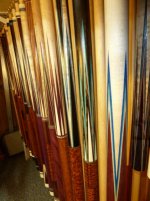
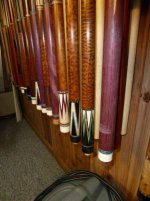
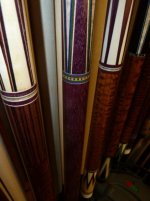






bumppp....for a really good question? what is your favourite wood combo for forearm and handle ....
50% of your forearm wood is birdseye MAPLE, curly MAPLE, or straight grain MAPLE and there is a reason for that. It plays great and looks good.Not to say others don't but MAPLE by far is the most popular. But I play with bocote because I like the feel of it.
Hi,
I agree with Trent and Greg about maple being the best material.
I use hard maple for the dowel for full cores on all my cues with an exceptional PH when a customer chooses a very light wood combo.
The pin end of the forearm has only .050 per side wall thickness of the wood species used for the front and as you travel back up the taper, the forearm, handle and butt sleeve wood's stock increases in volume to add it's flavor to the core's hit. The maple core buffers the different woods influence and the effects are more subtle because of the volumetric differential between the total core area v. rest of the wood stock.
The expansion Polyurethane Glue fills the annulus between the core and the dowel and forms a very hard bonding structure averaging about .007 per side of the dowel without gaps. After coring and gluing a cue the ring tone that the glue adds to the cue is incredible when you rap the side with a solid object. The same high pitched sound is heard if you rap the end of the dowel or the side of the cue in any spot.
When all is said and done, I believe after testing and getting double blind feed back info from top players, a 29" solid maple core gets me where I want my cues to be. Maple and glue builds a homogeneous design feature that you can feel and experience.
Putting wood combos together with great woods do produce unique sounds or ring tones that are very desirable but each time you put pieces together the variables in the individual pieces will influence the outcome totally different.
Even though all maple pieces are also different in the density, having it as the anchor for the core of the other woods with the glue produces cues that are closer to playing on a similar basis. The exotics are there to enjoy aesthetically but only factor a percentage of the feel the cue produces.
When I was building cues with all different wood combos and the A-Joint it was apparent that they all were very different in the way they played. Today my cues have an overall playability that is not the same on every cue but are very close. I like that and know the .016 filled gap over the 68 sq. in. of poly glue surface area filling the core has a big effect because of it's density as an advantage / virtue feature element.
Of coarse this is only my opinion. Like A-holes, "we all have one"!:duck:
Rick G
5 pointer on a 30" .736 dowel into a .750 cored hole before facing and assembly.
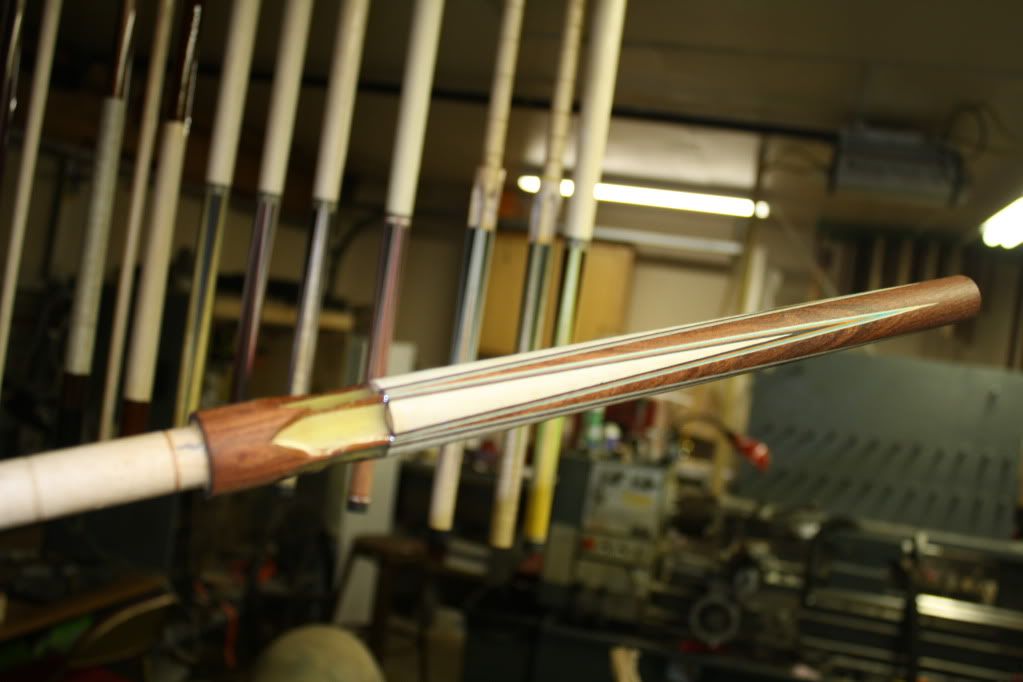
Last edited: